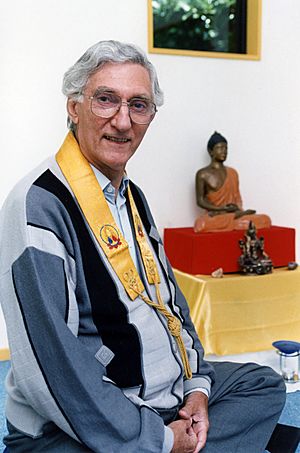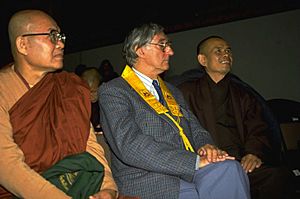Sangharakshita facts for kids
Quick facts for kids
Sangharakshita
|
|
|---|---|
 |
|
| Born |
Dennis Philip Edward Lingwood
26 August 1925 Tooting, London, England
|
| Died | 30 October 2018 (aged 93) Hereford, Herefordshire, England
|
| Nationality | British |
| Occupation |
|
| Organization | Friends of the Western Buddhist Order |
Sangharakshita (born Dennis Philip Edward Lingwood; August 26, 1925 – October 30, 2018) was a British spiritual teacher and writer. He founded the Friends of the Western Buddhist Order, which is now called the Triratna Buddhist Community.
He was one of the first Westerners to become a Buddhist monk after World War II. He spent over 20 years in Asia, where he learned from many different Buddhist teachers. In India, he helped with a movement to convert Dalits, also known as "Untouchables," to Buddhism. This movement was started in 1956 by B. R. Ambedkar. Sangharakshita wrote more than 60 books. Many people saw him as a very important Buddhist teacher who helped bring Buddhism to Western countries.
Sangharakshita officially retired in 1995. In 2000, he stepped down from leading the movement. However, he remained a key figure and lived at the community's main center in Coddington, Herefordshire. He passed away on October 30, 2018, after a short illness.
Contents
What Was Sangharakshita's Early Life Like?
Sangharakshita was born Dennis Philip Edward Lingwood in Tooting, London, in 1925. As a child, he had a heart condition. This meant he spent a lot of time in bed. He used this time to read many books.
He first learned about non-Christian ideas from a book called Isis Unveiled. After reading it, he felt he had never truly been a Christian. The next year, he found two Buddhist books, the Diamond Sutra and the Platform Sutra. He then realized he had always felt like a Buddhist.
When he was 18, Dennis Lingwood joined the Buddhist Society. In May 1944, he formally became a Buddhist. He did this by taking the Three Refuges and Five Precepts from a Burmese monk named U Thittila.
He joined the army in 1943. He served in India, Ceylon (now Sri Lanka), and Singapore. He worked as a radio engineer in the Royal Corps of Signals. In Ceylon, he met Hindu teachers. This made him want to become a monk. In 1946, he moved to Singapore. There, he met Buddhists and learned how to meditate.
His Spiritual Journey in India
After the war, Sangharakshita decided to stay in India. He wanted to focus on his spiritual path. He traveled around India for a few years. His companion was a young Buddhist, who later became Buddharakshita. They meditated and met famous spiritual leaders. These included Mata Anandamayi and Ramana Maharishi.
In May 1949, he became a novice monk. This ceremony was led by the Burmese monk, U Chandramani. He was given the name Sangharakshita. This name means "protected by the spiritual community." The next year, he became a fully ordained monk. He studied Buddhist texts and logic at Benares (Varanasi) University.
In 1950, Sangharakshita moved to Kalimpong. This was a hill town near the borders of India, Bhutan, Nepal, and Sikkim. It was also close to Tibet. Kalimpong became his home for 14 years.
What Did He Do in Kalimpong?
In Kalimpong, Sangharakshita started a Buddhist group for young men. He also created a center for practicing different types of Buddhism. He edited a journal and started a magazine. In 1951, he met Lama Govinda. Lama Govinda helped him appreciate Tibetan Buddhism more.
Sangharakshita was first ordained in the Theravada school of Buddhism. However, he felt that some Theravadin monks were too strict. He became more interested in Tibetan Buddhist teachers. Many of these teachers had fled Tibet after the Chinese invasion in the 1950s.
He began studying with the Gelug Lama, Dhardo Rinpoche. He also received teachings from other important teachers. These included Jamyang Khyentse Chökyi Lodrö, Dudjom Rinpoche, and Dilgo Khyentse Rinpoche. Dhardo Rinpoche later gave Sangharakshita a higher ordination. He also studied with a Ch'an teacher, Yogi Chen.
His Work with Dr. Ambedkar and Dalits
Sangharakshita worked with B. R. Ambedkar. Ambedkar was the main writer of India's constitution. He was also India's first law minister. Ambedkar had been a Dalit, a group historically treated as "Untouchables."
In 1956, Ambedkar converted to Buddhism. About 380,000 other Dalits joined him. Ambedkar and Sangharakshita had been writing to each other since 1950. Ambedkar encouraged Sangharakshita to expand his Buddhist work.
Ambedkar wanted Sangharakshita to lead his conversion ceremony. But Sangharakshita suggested U Chandramani should do it. Ambedkar died six weeks later. Sangharakshita continued Ambedkar's work. He gave talks to new Dalit Buddhists. He also led a ceremony where 200,000 more Dalits converted. For the next ten years, Sangharakshita visited many Dalit Buddhist communities in India.
Returning to the West
In 1964, Sangharakshita was asked to help at a Buddhist center in London. He became a very popular teacher there. His open-minded approach was different from the strict Buddhism at the center. He decided to stay in England.
After a farewell trip to India, he returned to England. In April 1967, he founded the Friends of the Western Buddhist Order. The Western Buddhist Order was created a year later. He ordained the first twelve men and women.
Sangharakshita felt that existing Buddhist groups in Britain were not quite right. He wanted to create a new form of Buddhism. This new order would be neither fully lay nor fully monastic. Members would take ten special rules, or precepts. These rules are a traditional part of Mahayana Buddhism.
At first, Sangharakshita led all classes and ordinations. He gave talks based on the main teachings of all Buddhist schools. As the order grew, other members took on more responsibility. In August 2000, he passed on his leadership duties to eight men and women.
Sangharakshita passed away at age 93 on October 30, 2018.
His Impact and Legacy

Sangharakshita is known as one of the first Westerners to dedicate his life to Buddhism. He was a very active writer, translator, and practitioner. He is sometimes called "the founding father of Western Buddhism." He was skilled at making Buddhist ideas understandable in the West.
For Sangharakshita, what connects all Buddhist schools is "going for refuge." This means turning one's life towards the values of the Buddha, Dharma (teachings), and Sangha (spiritual community). He saw this as a life-changing event.
Sangharakshita believed that spiritual growth is like a "higher evolution." He thought that women and men could both reach enlightenment. He ordained them equally from the start. He also saw connections between Buddhism and the ideas of the Romantics. They believed art had deep moral and spiritual meaning.
Sangharakshita wrote over 60 books. The Triratna Buddhist Community he founded has become very successful. It is one of the largest Buddhist movements in Britain. It also has centers in Europe, the Americas, Asia, and Africa. Many members are in India, continuing Dr. Ambedkar's mission. Experts estimate that about 100,000 people worldwide are connected to the Triratna Buddhist Community.
One of Sangharakshita's biggest contributions was making Buddhist ideas clear in Western languages. The Triratna Buddhist Community is open to all. It ordains both men and women equally. It has also created new ways of practicing Buddhism together. These include working together on projects that align with Buddhist values. This shows how Western ideas can be part of the Buddhist tradition.
See also
 In Spanish: Sangharakshita para niños
In Spanish: Sangharakshita para niños
- Dharmachari Subhuti – A close associate of Sangharakshita

